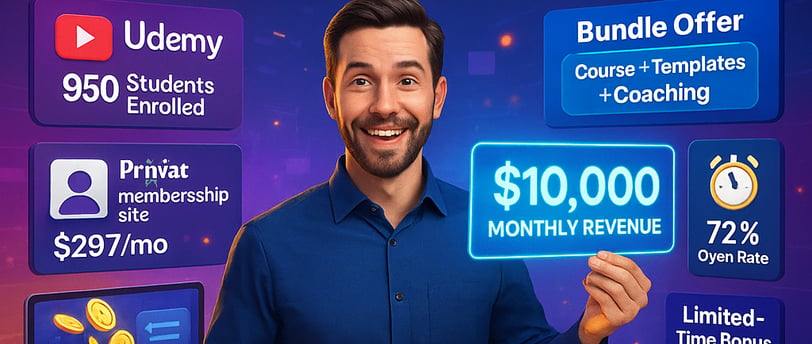Monetizing Your Online Courses: Strategies to Boost Sales and Engagement
Learn proven strategies to monetize your online courses effectively, increase sales, and keep learners engaged for long-term success.
ONLINE LEARNING PLATFORMS
6/4/20253 min read


ntroduction
Creating high-quality online courses is only half the battle—the real challenge lies in monetizing them effectively. With the online education market projected to reach $375 billion by 2026, there’s immense potential to generate revenue. However, success requires more than just listing courses for sale.
To truly monetize your online courses, you need a strategic approach that combines pricing, marketing, and engagement tactics. In this article, we’ll explore proven strategies to boost sales, retain learners, and maximize your revenue.
Strategy 1: Choose the Right Pricing Model
What It Is: Selecting a pricing strategy that aligns with your audience and course value.
Why It Matters: The right pricing model can attract more buyers and increase revenue.
Options to Consider:
One-Time Purchase: Charge a flat fee for lifetime access to the course.
Subscription Model: Offer monthly or annual access to a library of courses.
Pay-What-You-Want: Allow learners to choose their price, often with a minimum threshold.
Tiered Pricing: Offer different pricing levels with varying levels of access or features.
Pro Tip: Test different pricing models to see which one resonates most with your audience.
Strategy 2: Offer Free Trials or Samples
What It Is: Providing a limited version of your course for free to attract potential buyers.
Why It Matters: Free trials reduce hesitation and allow learners to experience the value of your course.
How to Implement:
Offer the first module or a few lessons for free.
Provide a time-limited trial (e.g., 7 days) for full access.
Use free samples as lead magnets to build your email list.
Pro Tip: Use tools like Thinkific or Teachable to easily create free trial versions.
Strategy 3: Bundle Courses for Value
What It Is: Combining multiple courses into a single package at a discounted price.
Why It Matters: Bundles increase perceived value and encourage larger purchases.
How to Implement:
Group related courses (e.g., “Digital Marketing Mastery Bundle”).
Offer a discount for purchasing the bundle versus individual courses.
Highlight the savings and benefits of the bundle.
Pro Tip: Use scarcity tactics like limited-time offers to create urgency.
Strategy 4: Upsell and Cross-Sell
What It Is: Offering additional products or services to existing customers.
Why It Matters: Upselling and cross-selling increase revenue per customer.
How to Implement:
Recommend advanced courses to learners who complete beginner courses.
Offer complementary products like eBooks, templates, or coaching sessions.
Use email marketing to promote upsell and cross-sell opportunities.
Pro Tip: Personalize recommendations based on the learner’s progress and interests.
Strategy 5: Leverage Affiliate Marketing
What It Is: Partnering with affiliates to promote your courses in exchange for a commission.
Why It Matters: Affiliates expand your reach and drive sales without upfront costs.
How to Implement:
Create an affiliate program with platforms like ShareASale or Refersion.
Provide affiliates with marketing materials like banners, emails, and social media posts.
Offer competitive commissions to incentivize affiliates.
Pro Tip: Partner with influencers in your niche to maximize affiliate sales.
Strategy 6: Build a Community Around Your Courses
What It Is: Creating a space for learners to interact, share progress, and support each other.
Why It Matters: A strong community increases engagement, retention, and word-of-mouth referrals.
How to Implement:
Use platforms like Discord, Slack, or Facebook Groups to build your community.
Host live Q&A sessions, webinars, or group challenges.
Encourage learners to share their achievements and feedback.
Pro Tip: Assign community moderators to keep discussions active and positive.
Strategy 7: Use Email Marketing to Nurture Leads
What It Is: Sending targeted emails to guide potential customers through the buying process.
Why It Matters: Email marketing builds relationships and keeps your courses top of mind.
How to Implement:
Create a series of welcome emails for new subscribers.
Share testimonials, success stories, and course highlights.
Offer exclusive discounts or bonuses to email subscribers.
Pro Tip: Use tools like Mailchimp or ConvertKit to automate your email campaigns.
Strategy 8: Optimize Your Sales Funnel
What It Is: Designing a seamless journey from discovery to purchase.
Why It Matters: A well-optimized funnel increases conversions and reduces drop-offs.
How to Implement:
Use clear, compelling CTAs like “Enroll Now” or “Start Learning Today.”
Simplify the checkout process to minimize friction.
Display trust signals like testimonials, reviews, and security badges.
Pro Tip: Use A/B testing to optimize landing pages and CTAs for higher conversions.
Real-World Example: How Monetization Strategies Boosted Sales
Let’s look at a real-world example of how these strategies helped an online course creator:
The Problem:
A photography course creator struggled to generate consistent sales despite having high-quality content.
The Solution:
They introduced a subscription model, offered free trial lessons, and built a community around their courses.
The Results:
The creator saw a 60% increase in revenue and a significant improvement in learner retention.
Conclusion
Monetizing your online courses requires a combination of strategic pricing, marketing, and engagement tactics. By implementing these proven strategies, you can boost sales, retain learners, and build a sustainable revenue stream.
Start applying these strategies today, and unlock the full potential of your online courses!
